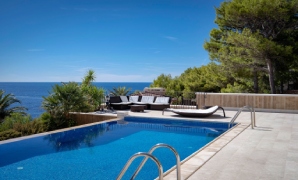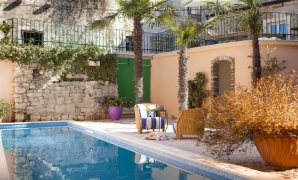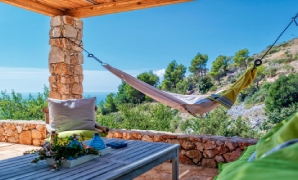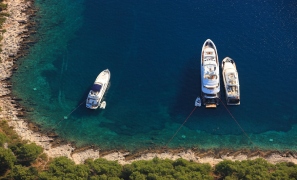Tucked away just two kilometres north of the lively Stari Grad lies Rudine , a village that feels like a whispered secret passed down through generations.
Split into Vela Rudina and Mola Rudina, this tiny hamlet, home to just 19 year-round residents, offers a rare kind of magic. Time slows down here. The air feels infused with history and the sun softer as it filters through olive groves. Rudine is a portal to another world, one where the echoes of the past linger in every stone wall and every swaying cypress.
Join us on a journey to Rudine — a place where the essence of Hvar is distilled into its purest form.
A village lost in time
Rudine is a paradox. Its quiet lanes, dotted with crumbling stone houses, hum with the energy of lives once lived. Over a century ago, this village was alive with 340 residents, their days spent tending the land, fishing the seas and crafting the island’s story. Now, only a handful remain, giving the village a surreal quality.
As you wander through Mola Rudina, the stillness is punctuated by the occasional creak of a shutter or the faint call of a distant bird. The heart of the hamlet, a tiny square, stands as a monument to the village’s past. Here, an olive mill, a grape press and a stone lantern rise like sentinels, guarding the stories of toil and triumph that once unfolded in this very spot.

Close your eyes. Can you hear it? The grind of millstones, the laughter of children, the melody of life as it was centuries ago…
Art in the ruins
If you’re lucky enough to visit in early August, the Rudine Art Festival presents a rare treat. Vela Rudina becomes a gallery without walls, where art spills from the ruins and breathes new life into abandoned homes. Local artists, alongside those with roots in the village, like renowned cartoonist Magda Dulčić, invite visitors into their world.
Here, art is not confined to frames or pedestals. It’s etched into the texture of the village itself — painted on stone walls, hung in sunlit courtyards or laid out under a sky heavy with stars. The festival’s informal charm allows you to meet the creators, sip wine made from nearby vineyards and feel like a part of this tight-knit artistic community.
Hidden shores and prehistoric secrets
Rudine’s magic extends far beyond its stone walls. A short 700-metre walk reveals some of the island’s most secluded beaches, where the Adriatic sparkles like liquid sapphire. Here, you won’t have to compete for space under the sun. Instead, you’ll find intimate coves where time seems to pause and the world feels impossibly wide.

One such treasure is Žukova Bay, where the footprints of ancient dinosaurs have been preserved in stone. Imagine standing where giants once roamed, the waves whispering tales of a time when the world was wild and untamed.

For the adventurous, the Kabal peninsula offers a labyrinth of hidden caves and secret shores. Ascend to its highest point and you’ll discover a relic of the Cold War: Tito’s tunnels. Dug into the rocky heart of the peninsula, these secret passages were built to defend against imagined invasions. Step inside and the temperature drops, the air thick with mystery. When you emerge, let the view of the sun dipping into the Adriatic fill your senses. This is the kind of sunset that poets dream of, a kaleidoscope of gold, coral and violet painted across the horizon.
The flavours of Rudine
Rudine’s story isn’t just told through its landscapes; it’s also written in its flavours. The village is renowned for its saffron, a golden thread that weaves its way into the island’s culinary traditions. Together with honey, it transforms into the key ingredient of paprenjok, a spiced biscuit that has become a symbol of nearby Stari Grad.

As you explore Rudine, the scent of rosemary, lavender and wild thyme drifts with the breeze. These fragrant herbs, along with olives and figs, form the backbone of the island’s Mediterranean cuisine — a cuisine that is as timeless as Rudine itself and protected by UNESCO as intangible cultural heritage.
A stone’s throw from Stari Grad
When the tranquillity of Rudine leaves you craving a touch of vibrancy, Stari Grad awaits just a short stroll or bike ride away. Founded in 384 BC by Greek settlers, the town is a treasure trove of ancient history and modern touches. Wander its cobbled streets, marvel at its UNESCO-listed Stari Grad Plain and enjoy a taste of island life at its cafes and galleries.
Yet, even here, Rudine’s spirit lingers. The saffron that colours Stari Grad’s paprenjok biscuits comes from Rudine’s fields, a testament to the enduring bond between the two places.
Why Rudine captures hearts
Rudine is more than a destination — it’s a feeling, an invitation to slow down and indulge in the beauty of simplicity. Whether you’re exploring its stone paths, basking on its quiet beaches or marvelling at its artistic soul, Rudine has a way of leaving a mark on your heart.

This is a place that asks nothing of you but to be present. To feel the sun on your skin, the cool sea breeze in your hair and the weight of history in every step. And when you leave, it’s not really goodbye, because Rudine stays with you as a gentle reminder that sometimes the smallest, quietest places hold the greatest treasures.
So come see for yourself. Let Rudine’s whispers of the past guide you into the present, and perhaps, if you’re lucky, leave you dreaming of its enduring beauty for years to come. With Villas Hvar, your dream is our reality.




